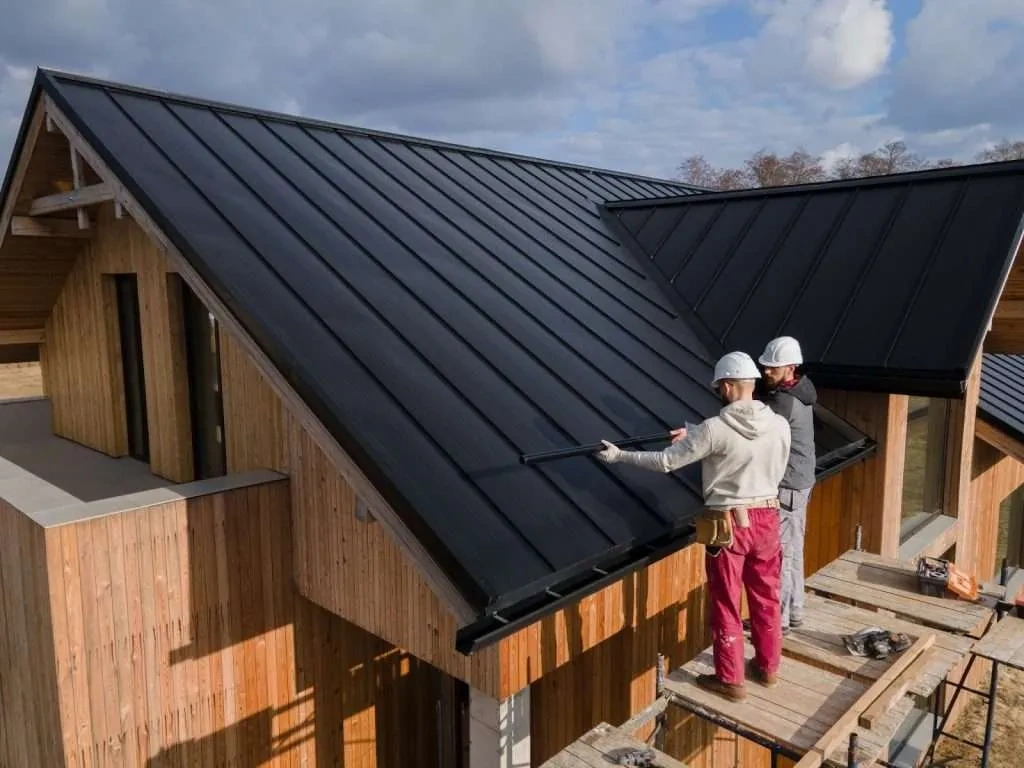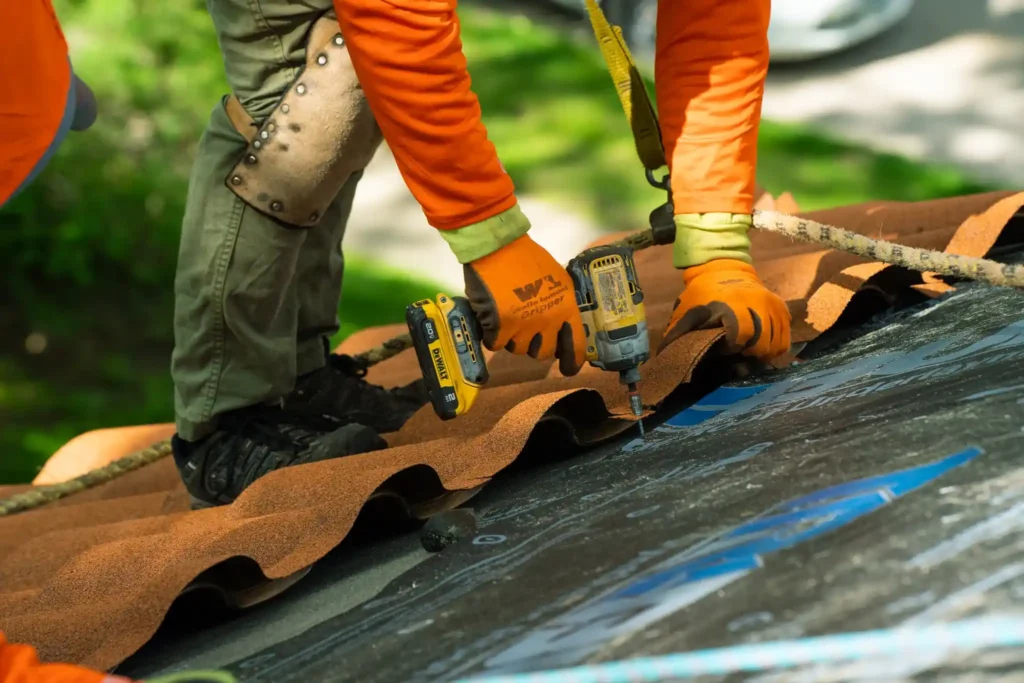Choosing the right roofing material is essential for home durability. Various factors influence this decision, including climate, style, and budget. Certain materials, like metal and slate, provide exceptional longevity, yet come with higher costs. Understanding the nuances of local weather patterns can greatly impact material selection. This analysis will guide homeowners in making informed choices that guarantee their roofs endure the elements effectively. What key aspects should be prioritized when evaluating these options?
Key Takeaways
- Evaluate your local climate to select roofing materials that will withstand weather conditions and enhance longevity.
- Consider the architectural style of your home to ensure aesthetic compatibility with the chosen roofing material.
- Balance your budget with the lifespan of materials; investing in durable options can save money in the long run.
- Consult with roofing professionals for expert insights on material selection and installation best practices.
- Prioritize regular maintenance and inspections to prolong the durability and integrity of your roof.
Understanding Your Roofing Needs
How can homeowners accurately assess their roofing requirements? Understanding the specific needs of a home is essential for making informed decisions regarding roofing materials. Homeowners should begin by evaluating their local climate, as this influences the longevity and performance of various materials. Additionally, they must consider the architectural style of their home, as aesthetic compatibility is vital for maintaining curb appeal. Budget constraints play a pivotal role, guiding selections towards materials that not only fit financial considerations but also offer durability. Finally, consulting with roofing professionals can provide insights on how to choose the best roofing material, ensuring that choices align with both practical needs and personal preferences. This thorough assessment fosters a sense of belonging within the homeowner community.
Popular Roofing Materials and Their Durability
While various roofing materials are available, their durability greatly influences their suitability for specific homes. Asphalt shingles, a popular choice, typically last 15 to 30 years, offering an economical option for many homeowners. Metal roofing, known for its longevity, can endure 40 to 70 years, providing excellent resistance to severe weather conditions. Clay and concrete tiles, while more costly, boast durability that can exceed 50 years, making them ideal for long-term investments. Slate roofs stand out with a lifespan of over 100 years, although their weight requires careful structural consideration. When determining how to choose the best roofing material, residents should weigh these options against their desired longevity, maintenance requirements, and overall aesthetic preferences for a cohesive home exterior.
Climate Considerations When Choosing Roofing
When selecting roofing materials, it is essential to contemplate the local climate, as different environments can greatly impact the performance and longevity of various options. For instance, areas prone to heavy snowfall require materials that can handle significant weight, like metal or slate. Conversely, regions with intense sunlight may benefit from reflective materials that reduce heat absorption, such as light-colored shingles or metal roofing. In coastal areas, resistance to salt corrosion is critical, making materials like fiberglass-reinforced asphalt shingles advantageous. Additionally, high wind zones necessitate materials that can withstand strong gusts, such as impact-resistant shingles. Understanding these climate considerations is fundamental for homeowners aiming to choose the best roofing material for durability and long-term protection.
Cost vs. Longevity: Finding the Right Balance
Selecting roofing materials involves not only understanding climate considerations but also evaluating the cost versus longevity of different options. Homeowners must assess the initial investment against the expected lifespan of roofing materials. For instance, asphalt shingles are generally lower in upfront cost but may require replacement every 15-30 years, while metal or slate roofs, though more expensive initially, can last 50 years or more. This longevity can lead to reduced long-term costs, as fewer replacements are needed. Consequently, striking a balance between immediate affordability and future durability is essential. Making an informed decision on how to choose the best roofing material can greatly impact both financial planning and home protection, enhancing the overall value of the property.
Professional Installation and Maintenance Tips
Professional installation and regular maintenance are critical factors in maximizing the lifespan and performance of roofing materials. Engaging qualified roofing contractors guarantees proper techniques are employed, adhering to manufacturer guidelines and local building codes. This minimizes risks related to leaks, structural damage, and premature failure. Homeowners should prioritize regular inspections, ideally twice a year, to identify wear, debris buildup, or damage from severe weather. Prompt repairs can prevent more extensive issues, preserving the roof’s integrity. Additionally, maintaining proper attic ventilation and insulation plays a crucial role in enhancing roof durability. By understanding how to choose the best roofing material and guaranteeing expert installation and ongoing care, homeowners can foster a secure and resilient living environment.
Frequently Asked Questions
What Are the Environmental Impacts of Different Roofing Materials?
Different roofing materials greatly impact the environment. Asphalt shingles contribute to landfill waste, while metal options offer recyclability. Green roofs enhance biodiversity, whereas concrete tiles have high embodied energy, affecting sustainability and resource consumption.
How Do Roofing Materials Affect Home Energy Efficiency?
Roofing materials greatly influence home energy efficiency by affecting heat absorption and insulation. Reflective materials can reduce cooling costs, while properly insulated roofs minimize heat loss, ultimately contributing to lower energy consumption and enhanced comfort.
Can I Install a New Roof Over an Existing One?
Yes, a new roof can be installed over an existing one, provided local building codes permit it. This method may save time and costs, but thorough inspection of the underlying structure is essential for long-term durability.
What Warranties Are Available for Roofing Materials?
Various warranties are available for roofing materials, including manufacturer warranties covering defects, labor warranties for installation, and limited lifetime warranties. Each type varies in duration and coverage, ensuring protection against potential failures or damage.
How Do I Inspect My Roof for Damage?
To inspect a roof for damage, one should visually examine shingles for cracks or missing pieces, check flashing for leaks, and assess gutters for debris. Additionally, look for signs of water stains inside the home.
Conclusion
In summary, selecting the appropriate roofing material for durability necessitates a thorough evaluation of individual needs, material characteristics, and environmental factors. Options such as metal and slate, while initially costly, provide significant longevity and resilience. Careful consideration of local climate conditions and a balanced approach to cost versus lifespan are essential. Ultimately, enlisting professional guidance for installation and ongoing maintenance is vital for maximizing the longevity and performance of the chosen roofing solution, ensuring the best protection for the home.
You May Also Like To Read:


